Laid-off H-1B visa holders in the U.S. face new challenges as Notices to Appear in immigration court are issued before the grace period ends, creating uncertainty for many families.
H-1B visa holders who lose their jobs and receive a Notice to Appear (NTA) in immigration court are navigating a complex and evolving legal landscape. Typically, laid-off H-1B workers are granted a 60-day grace period to secure new employment or change their visa status. However, recent reports indicate a troubling trend: NTAs are being issued before this grace period has expired, leading to increased anxiety and uncertainty for many visa holders and their families.
According to the Pew Research Center, approximately 400,000 H-1B visas were approved in 2024, with 73% of those going to workers from India. Most of these visas are renewals, highlighting the significant reliance on this visa category among Indian nationals.
To gain insight into the current situation, India Currents spoke with Sameer Khedekar, Founder and Managing Attorney at Vanguard Visa Law in California. The following discussion, lightly edited for clarity, sheds light on the recent changes affecting H-1B visa holders.
Sameer began by outlining the broader implications of recent changes in the H-1B visa process. He noted that a February memo from USCIS indicated that NTAs would be issued to anyone lacking lawful status in the U.S. Initially, this seemed reasonable, but by July, reports emerged of H-1B workers being laid off and subsequently receiving NTAs.
When an H-1B worker leaves their job, whether through a layoff or voluntarily, the employer is required to notify USCIS. This notification triggers the issuance of an NTA, regardless of the employee’s subsequent actions to maintain their status, such as applying for a new job or changing their visa status.
Historically, H-1B holders have enjoyed a 60-day grace period to seek new employment or change their status. This grace period has been uniformly granted since its implementation in 2016. However, the current administration’s approach appears to be eroding this safety net, as NTAs are being issued without consideration of the grace period.
Sameer explained that when an H-1B holder leaves their employer, the withdrawal of their H-1B status often triggers an automatic NTA. This occurs regardless of whether the individual has taken steps to apply for a new H-1B, H-4, or B-1/B-2 visa. Consequently, many individuals find themselves in immigration court, even when they have acted to preserve their status.
While some cases have been dismissed in court due to applicants demonstrating that they maintained their status, the outcomes can vary significantly depending on the judge and the court. The recent wave of layoffs from major companies like Microsoft and Intel has compounded the issue, creating chaos for many H-1B holders.
For those facing layoffs, it is crucial to understand the timing of when their employer will withdraw their H-1B status. Sameer recommended that employees proactively discuss with their employers the possibility of delaying the withdrawal until after the grace period has ended. This conversation, while potentially awkward, is essential given the current climate.
Sameer also highlighted the emotional toll this situation takes on families, particularly those who have lived in the U.S. for many years. The fear of separation due to immigration proceedings is palpable, especially among families with children who have grown up in the U.S.
In terms of legal options, Sameer emphasized the importance of taking action during the grace period. If a visa holder is unable to secure employment within the 60-day window, leaving the country before an NTA is issued is the safest course of action. This approach allows for a case dismissal if the individual departs before the NTA is formally issued.
For those who do receive an NTA, Sameer advised that filing for a change of status to H-4 or applying for a B-1/B-2 visa can help maintain legal status. Even if a job offer is pending, having an application on file can be sufficient to convince the courts to dismiss the case.
Sameer also addressed the challenges faced by non-working spouses and children of H-1B holders. The anxiety surrounding potential deportation can be overwhelming, especially for families who have built their lives in the U.S. Fortunately, many individuals have successfully navigated the legal system to maintain their status, but the process remains fraught with uncertainty.
As the situation continues to evolve, Sameer encouraged H-1B visa holders to remain vigilant and proactive. Monitoring the status of their visa and seeking legal counsel tailored to their individual circumstances is essential. Engaging a personal immigration attorney, rather than relying on company resources, can provide the necessary support in navigating these complex issues.
In conclusion, the current landscape for H-1B visa holders is marked by uncertainty and anxiety. As the government tightens regulations and issues NTAs more frequently, it is crucial for visa holders to understand their rights and options. By taking proactive steps and seeking legal guidance, individuals can better navigate this challenging environment.
Source: Original article

